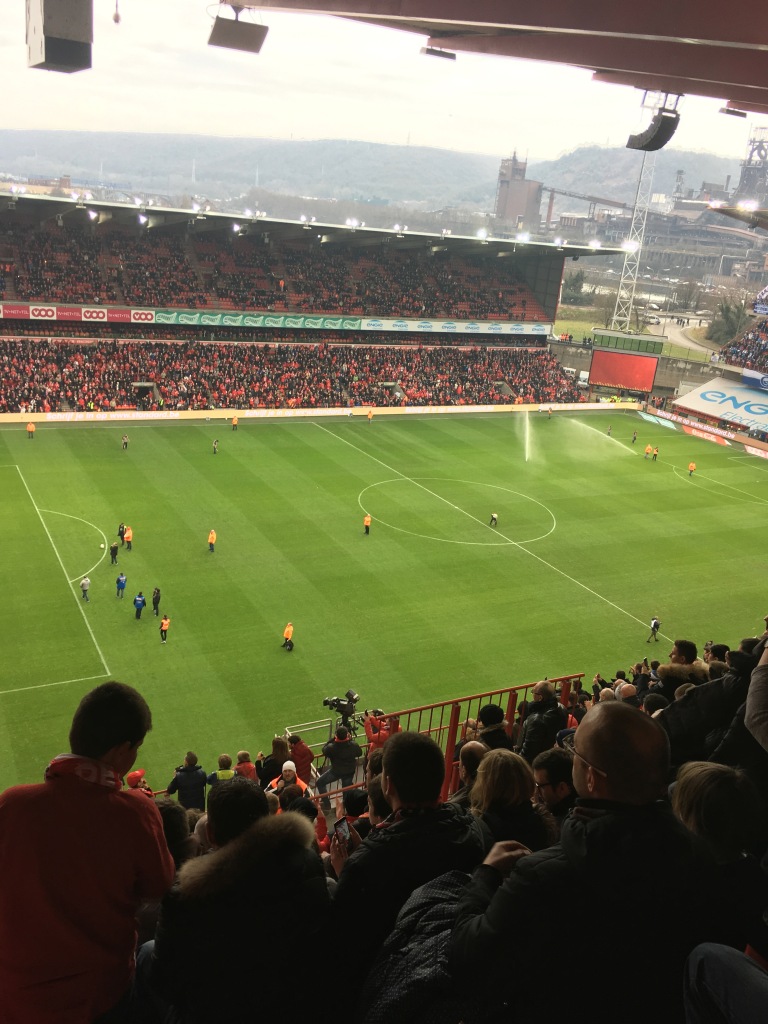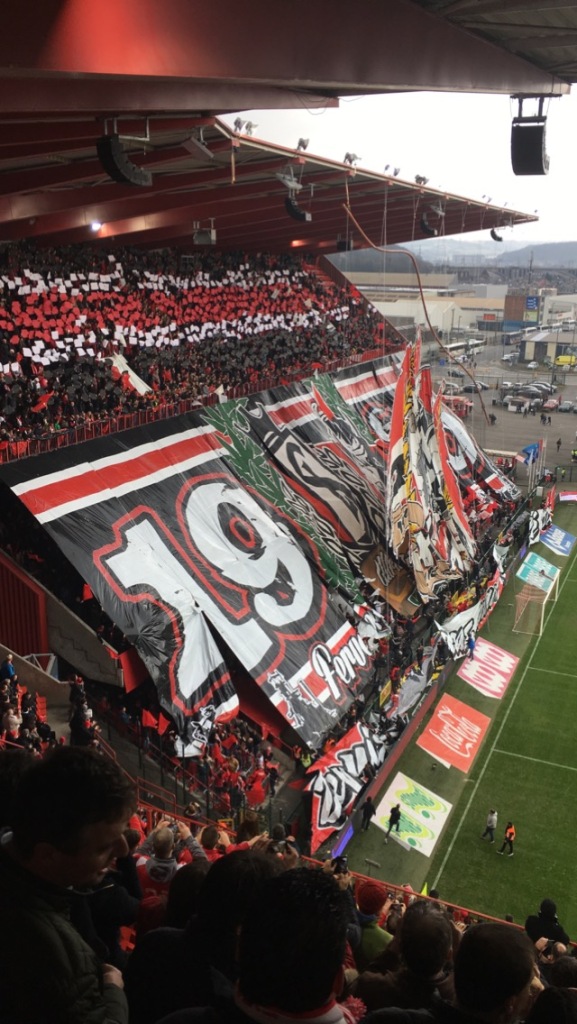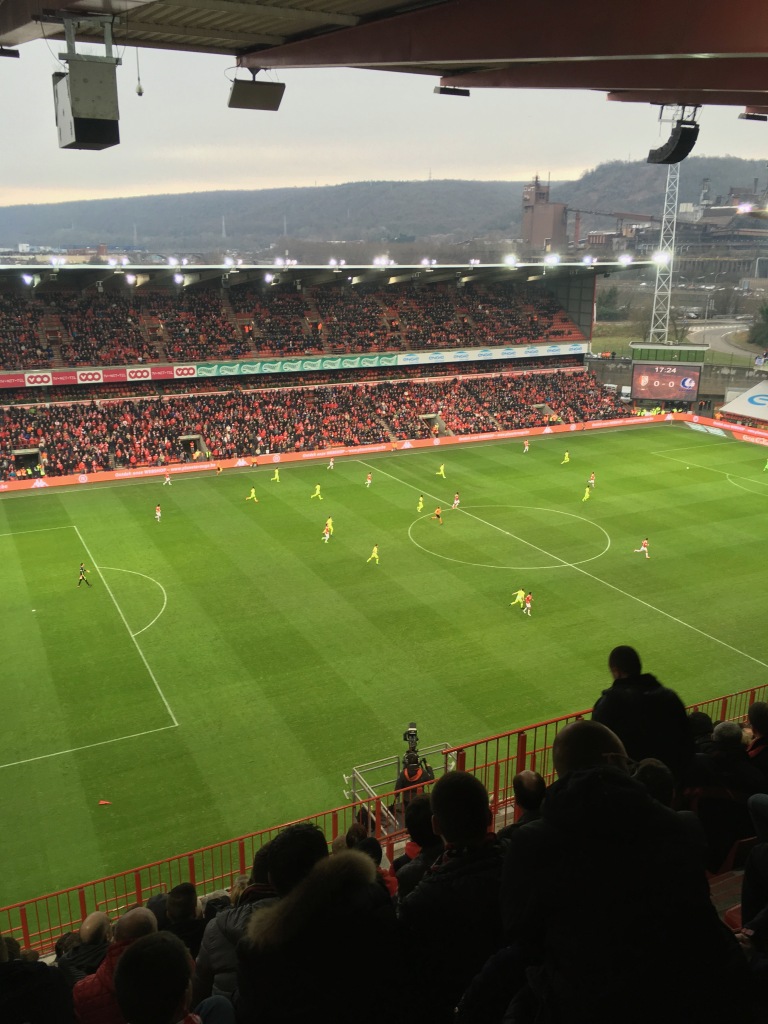When I booked a train from Strasbourg to Gent in February 2017 to visit friends for a long weekend, I had hoped that my trip would coincide with a game at the Ghelamco Arena: the newly-built home of Belgian side KAA Gent. A quick scan of the fixture list informed me however that Hein Vanhaezebrouck’s side, competing in the Europa League that season, were facing Standard Liège away from home on the Sunday. Undeterred by the two hour journey there and back, I decided to take advantage of the reduced Belgian train fares for those under 25 and venture down to the towering Stade Maurice Dufrasne for a memorable dose of Jupiler League action.

Belgian sausage rolls and Valencian architecture
After a quick pastry from Panos, Belgium’s ambrosial answer to Greggs, I set off for Liège from the magnificent Gent-Sint-Peters train station on the south side of the city. With the train darting towards deepest Wallonia at full speed, I had earmarked a few Liège players as ones to watch ahead of kick-off: Orlando Sá, once of Fulham and latterly Reading; Ishak Belfodil, at the time heavily linked with a move to Ronald Koeman’s Everton; and Mathieu Dossevi, the diminutive Togolese international whose career had started in France with Le Mans. The opposition, KAA Gent, had less than 72 hours earlier produced a resillient display to defeat Mauricio Pochettino’s Tottenham Hotspurs 1-0 in the knockout stages of the Europa League. With Standard Liège possessing such an exciting, albeit frustratingly inconsistent, group of players and Gent understandably high in confidence following their European endeavours, I was hopeful that I would see an entertaining 90 minutes or so of football.
Our train drew into the somewhat incongruous Gare de Liège-Guillemins an hour or so before the late afternoon kick-off. The train station, designed by renowned Valencian architect Santiago Calatrava and opened in September 2009, is majestic, dreamlike and, to an extent, intimidating in its modern beauty. Contrasted with the exalted 17th and 18th century Mosan architecture synonymous with Belgium’s third largest city, Liège-Guillemins has the undeniable air of a gleaming spaceship hastily abandoned and subsequently harnessed for use as a transport hub welcoming businessmen, holiday-goers and football fans alike. It’s divisive to say the least.
An apologetic taxi driver and an unforgiving stadium
Wary of time and the deceptive two-mile walk out to the ground, we bundled ourselves into the nearest taxi. Our driver seamlessly twisted and turned through narrow side streets, artfully evading wave after red wave of Liège fans spilling out onto the road from the overcrowded pavements. With the ground in sight, the taxi drew to a halt and the driver apologetically informed us that this was as far as he could take our group.
The short walk thereafter to the ground did however provide us with the perfect opportunity to fully appreciate the wonderfully industrial home of Standard Liège. Situated on the banks of the River Meuse, Stade Maurice Dufrasne protrudes menacingly into the Wallonian sky. It is a blood-red colosseum boasting nauseatingly steep terraces and, on match days at least, a fiery atmosphere befitting of the iron and steel industries that once thrived in this part of the world.
Electric atmosphere
If somebody were to ask me which of the grounds I have been lucky enough to visit over the years might lay claim to the greatest atmosphere, I would tell them without hesitation about that overcast Sunday afternoon in south-eastern Belgium. That Liège had been having a disappointing season by their once-imperial standards seemed to have done little to dampen spirits both inside and outside the ground. Each and every fan was on their feet as what sounded like a reworking of the timeless Zombie Nation blasted from the strategically positioned speakers dotted around the stadium.

The noise was relentless, scintillating and at times deafening. Minutes before the two teams emerged onto the pitch, the inexorable Ultras Inferno to our left unfurled a mesmeric tifo display commemorating the group’s 20th year. I would later learn that this display was, allegedly, the largest such display in the history of Belgian football.
No shortage of early chances
The first real opening of the game would come after seven minutes. A beautifully weighted pass from Liège defender Miloš Kosanović picked out the potent Belfodil in a promising area inside the box. From a tight angle, the Algerian flashed a menacing shot across goal. Gent stopper Lovre Kalinić, now at Aston Villa, could only parry the ball straight to Orlando Sà in a central position six yards out but the former Fulham striker’s header was tame and easily gathered by the relieved Kalinić.

Less than a minute later, Sà would once again benefit from a Kalinić fumble and the Serbian keeper would once again benefit from a stroke of luck. Aggressive pressing from Liège full-back Collins Fai allowed the Cameroonian international to win possession back in the final third out on the right wing. The former Dinamo București man then drilled a wicked low cross into the six yard box. Caught in two minds, Kalinić palmed the ball in the direction of the onrushing Sà. With Sà unable to react in time, the ball ricocheted off the Portuguese forward’s thigh and the shin of La Gantoise defender Stefan Mitrovic as it sped agonisingly past the post.
Those portentous let-offs ought really to have served as a wake-up call for the disjointed away defence. And yet, with twenty minutes on the clock Ishak Belfodil was inexplicably left all on his own twelve yards out with a gilt-edged opportunity to break the deadlock. When La Gantoise failed to fully clear a corner from the left, the ball fell to the explosive figure of Edmilson Junior. The Belgian-born Brazilian’s misguided shot somehow bypassed the entire Gent backline, inadvertently finding Belfodil in acres of space inside the box. Perhaps unaware of just how much time he actually had, Belfodil snatched his shot on the turn and fired an effort straight into the arms of a grateful Lovre Kalinić.
Deserved breakthrough
The away side’s luck would however run out shortly before half-time, with Liège opening the scoring in emphatic style. Collins Fai’s floated ball down the right flank was taken down expertly by Matthieu Dossevi. The Togolose international then whipped an inviting delivery towards Orlando Sà, whose sumptuous half-volley from twelve yards out flew past a helpless Kalinić.
It would, in all honesty, be difficult, nigh-on impossible, to find words that would do proper justice to the remarkable celebrations that then ensued in the traditional old ground. As the red and white netting rippled resplendently, Liège’s number 70 wheeled away in jubilant celebration. The chaotic goal anthem now engulfing the traditional old ground provided the apposite soundtrack for the senseless flailing of hands, feet and elbows of the anarchic home support. The pocket of Gent fans over to our right, noisy enough until now, could only look on in bitter admiration. With order just about restored, the referee’s whistle moments later signalled the end of what had been both an encouraging and breathtaking first-half from Aleksandar Janković’s side.
Mitrovic levels
For all Liège’s first-half dominance, their visitors nevertheless managed to find an equaliser barely five minutes after the restart. A deep, angled cross from Ghanaian veteran Nana Akwasi Asare picked out Kalifa Coulibaly at the far post. The Malian striker’s cushioned header back across the six yard box found its way rather fortuitously to Stefan Mitrovic via the outstretched boot of Liège defender Alexander Scholz. Mitrovic, a no-nonsense, irascible centre-half now plying his trade in Alsace for Racing Strasbourg, composed himself admirably before stroking the ball calmly past three or four lunging Liège bodies and goalkeeper Jean-François Gillet to bring his side level.
Controversy in Belgrade
Mitrovic of course infamously found himself at the centre of a politically fraught Euro 2016 qualifier in Belgrade a few years ago. 40 minutes into Serbia’s home fixture with Albania, a drone carrying the flag of Greater Albania floated provocatively into view above the field of play. The concept of ‘Greater Albania’ envisages a political unification of all lands in which ethnic Albanians reside – that would include Kosovo, a nation that declared its independence from Serbia in 2008. Against that taut geo-political backdrop, Mitrovic, flanked by Sevilla midfielder Nemanja Gudelj and the ever-sullen Aleksandr Kolarov, plucked the flag symbolically out of the air.
That gesture struck a chord in a catatonic corner of continental Europe, seemingly incensing several Albanian players. Taulant Xhaka, brother of oft-maligned Arsenal captain Granit, accosted a defiant Mitrovic and grappled the flag away from him. Albanian forward Bekim Balaj picked up the flag and made a beeline for the touchline, only to find his path there irresponsibly and incomprehensibly blocked by Serbian substitute Nemad Tomovic. Violence then inevitably ensued between players, fans and team officials alike with referee Martin Atkinson ultimately abandoning the game. I digress, but quite the red wedding.
The search for a winner
While Mitrovic’s February afternoon in Liège was somewhat less politically charged, the home side’s attack nevertheless ensured that the Serb was kept busy for the remainder of the second-half at Stade Maurice Dufrasne. Orlando Sà’s glancing header with an hour gone narrowly missed the target. Matthieu Dossevi’s shot on the turn after 65 minutes was well gathered by Lovre Kalinić. Ishak Belfodil, anonymous for large parts of the game, flashed an inviting delivery across the face of goal soon after but neither Dossevi nor Sà were able to find the crucial touch and turn the ball goalward. That Sà could only guide a late, cushioned effort over the bar, following a powerful run down the left, exemplified an indisputable lack of cutting edge that had plagued Aleksandar Janković’s side throughout the ninety minutes.
Full time: Standard Liège 1 – 1 KAA Gent
Following two dropped points and an alarmingly wasteful performance, the sort of which had become all-too-familiar that season for the ten-time Belgian champions, Jankovic’s days in south-east Belgium were inevitably numbered. Less than two months after the draw with Gent, the Serbian coach, now in charge of the under-20 side for the Chinese national team, would be shown the door. He left his post with the team languishing in the bottom half of the table and a win percentage of just 25%. The breathtaking fanbase at Standard Liège deserved better.
An unparalleled experience
For me, there was something quite inimitable about the match-day experience at Stade Maurice Dufrasne. Perhaps it was the no-nonsense fans or the (relatively) cheap pre-match, half-time and post-match beer. Perhaps it was the vertiginous stands or the spectacular tifo displays. Perhaps it was the strangely comforting industrial backdrop visible from our lofty vantage point. Perhaps it was the intoxicating goal anthem that enveloped the ground as an unshackled Orlando Sà, a far-cry from the oft-forlorn figure that once frequented the Madjeski Stadium in Berkshire, found the net with the sweetest of half-volleys. Regardless, Standard Liège, and indeed the Belgian Jupiler League as a whole, have a lot to offer. Long may that continue.

Sounds like a venue with incredible atmosphere. Passionate fans in a sports chamber with plenty of character
LikeLiked by 1 person
Great place to watch football.
LikeLike